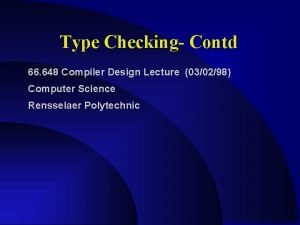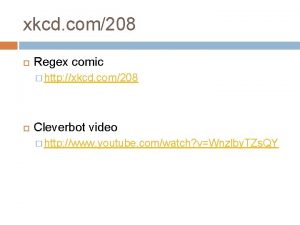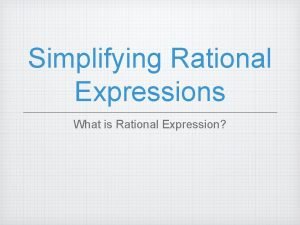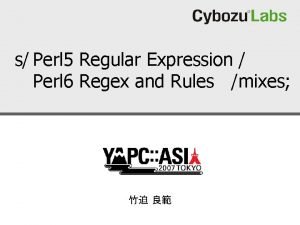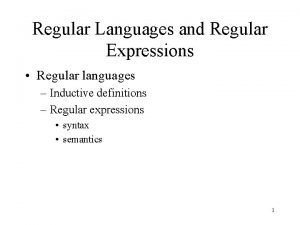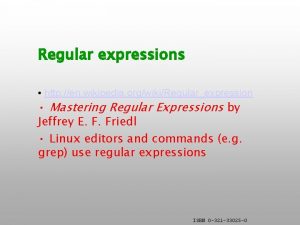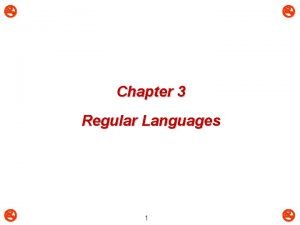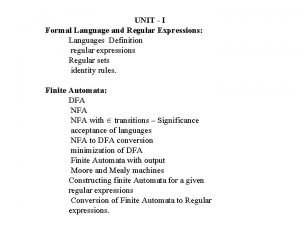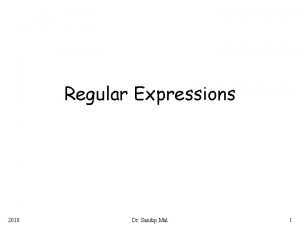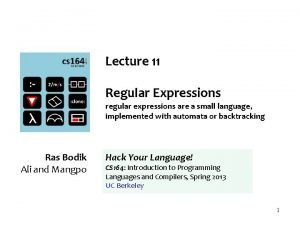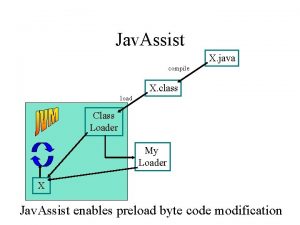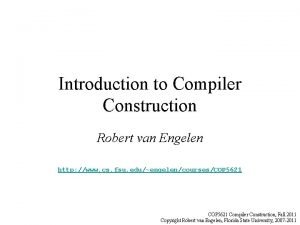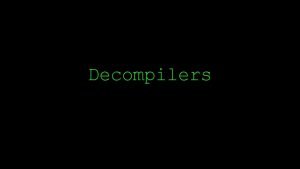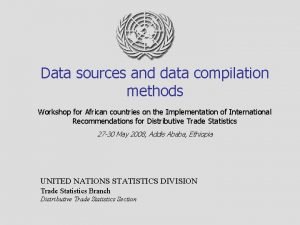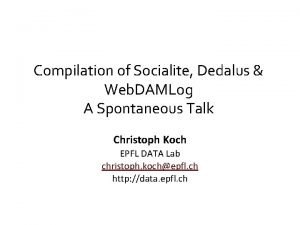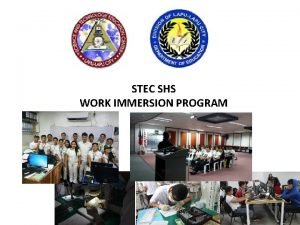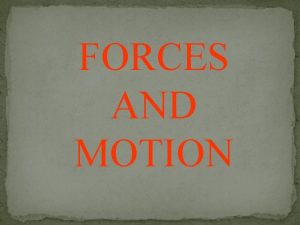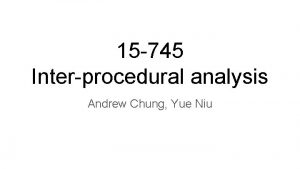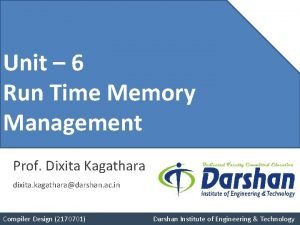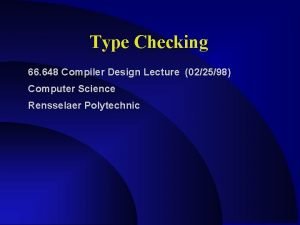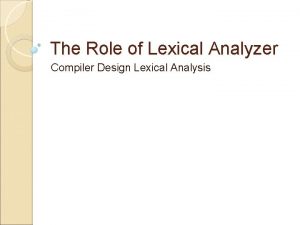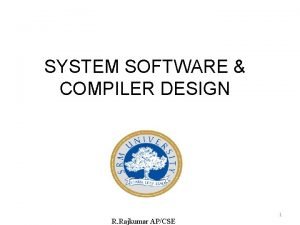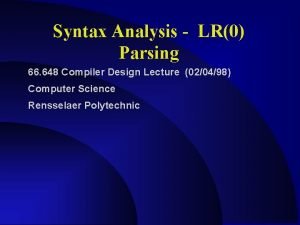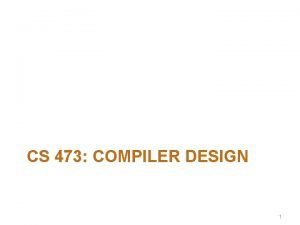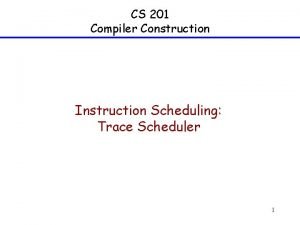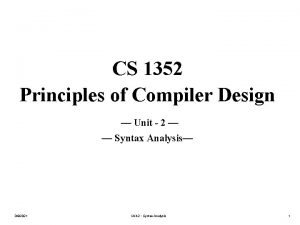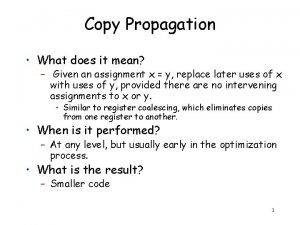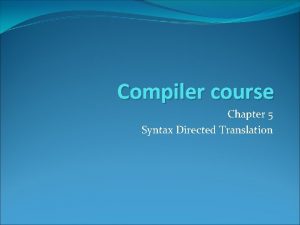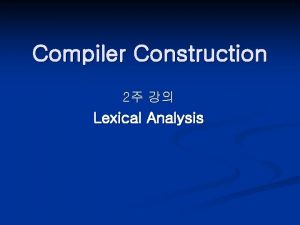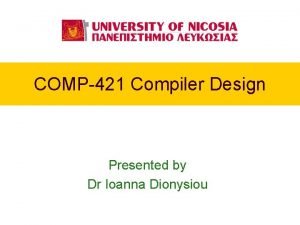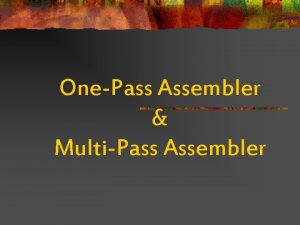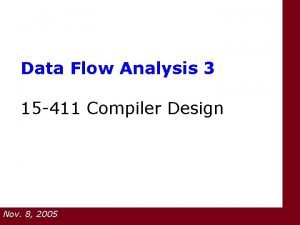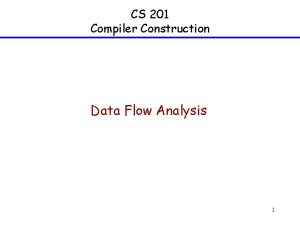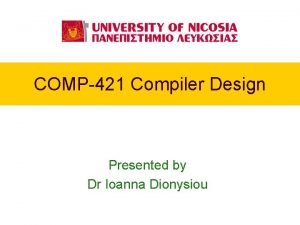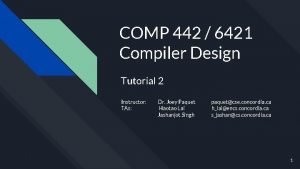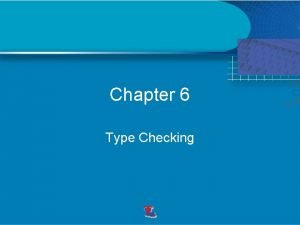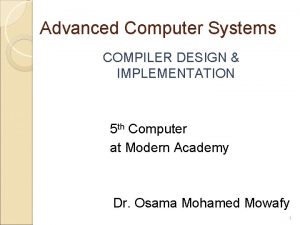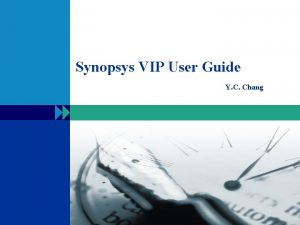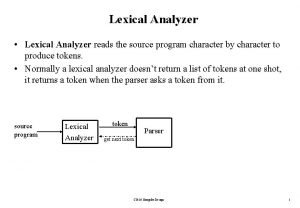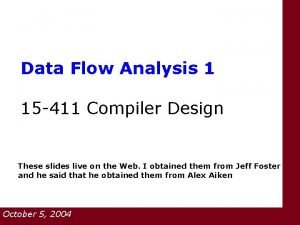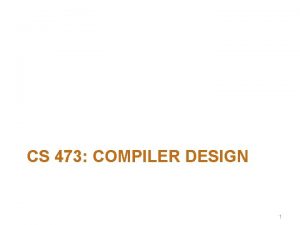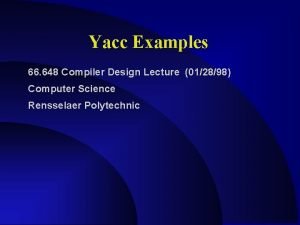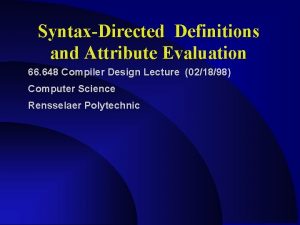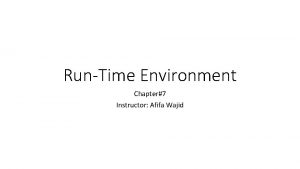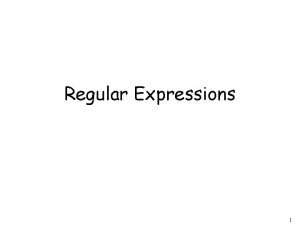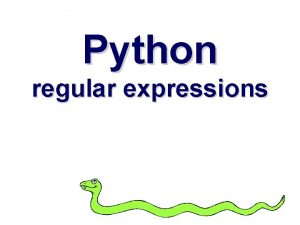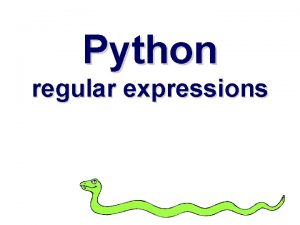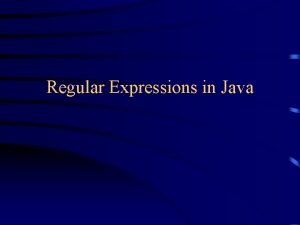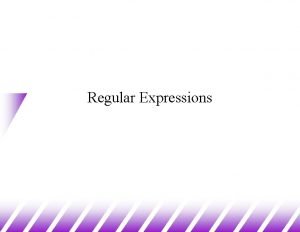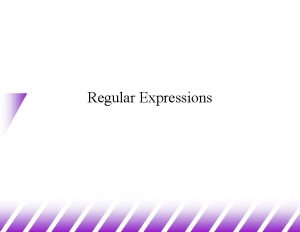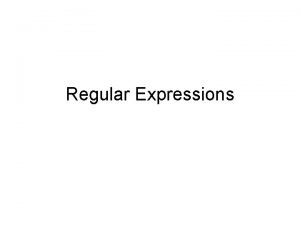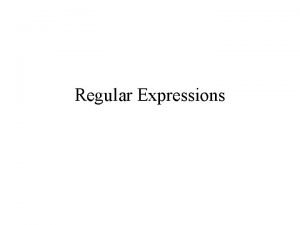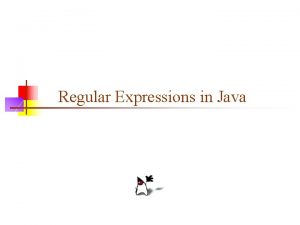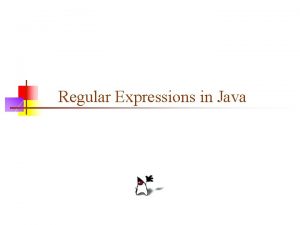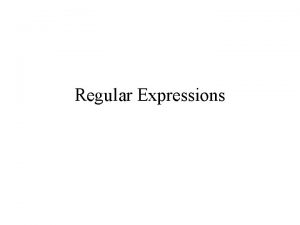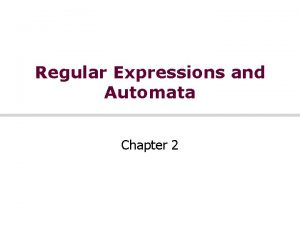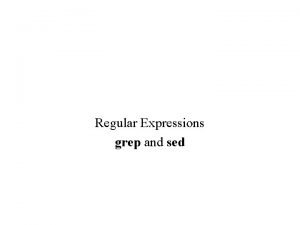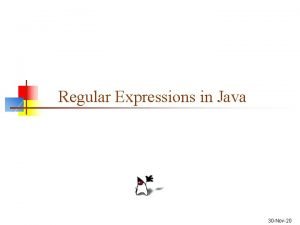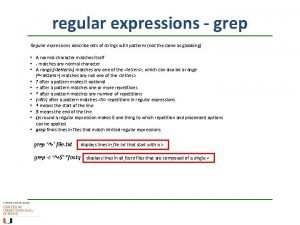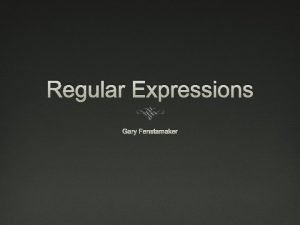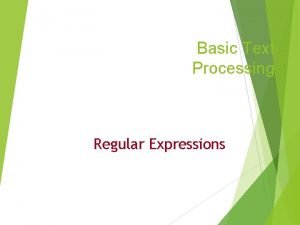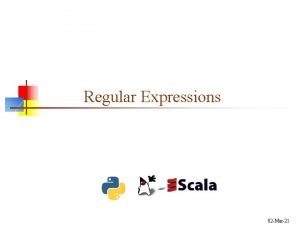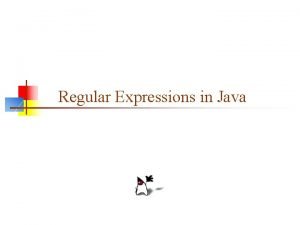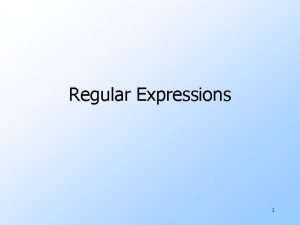Compiler Design Parsing Parsing During Compilation regular expressions
























































- Slides: 56

Compiler Design


Parsing

Parsing During Compilation regular expressions source program lexical analyzer errors token get next token parser symbol table • uses a grammar to check structure of tokens • produces a parse tree • syntactic errors and recovery • recognize correct syntax • report errors parse tree • • • rest of front end intermediate representation Collecting token information Perform type checking Intermediate code generation

Errors in Programs

Error Detection

Adequate Error Reporting is Not a Trivial Task

ERROR RECOVERY

ERROR RECOVERY MAY TRIGGER MORE ERRORS!

ERROR RECOVERY APPROACHES: PANIC MODE

ERROR RECOVERY APPROACHES: PHRASE-LEVEL RECOVERY

ERROR RECOVERY APPROACHES: ERROR PRODUCTIONS

ERROR RECOVERY APPROACHES: GLOBAL CORRECTION

Parsers

CONTEXT FREE GRAMMARS (CFG) A context-free grammar has four components: G = ( V, Σ, P, S ) üA set of non-terminals (V). Non-terminals are syntactic variables that denote sets of strings. The nonterminals define sets of strings that help define the language generated by the grammar. üA set of tokens, known as terminal symbols (Σ). Terminals are the basic symbols from which strings are formed. üA set of productions (P). The productions of a grammar specify the manner in which the terminals and nonterminals can be combined to form strings. Each production consists of a non-terminal called the left side of the production, an arrow, and a sequence of tokens and/or on- terminals, called the right side of the production. üOne of the non-terminals is designated as the start symbol (S); from where the production begins.

Example of CFG: G = ( V, Σ, P, S )Where: V = { Q, Z, N } Σ = { 0, 1 } P = { Q → Z | Q → N | Q → ℇ | Z → 0 Q 0 | N → 1 Q 1 } S={Q} ØThis grammar describes palindrome language, such as: 1001, 11100111, 00100, 1010101, 11111, etc.

RULE ALTERNATIVE NOTATIONS

NOTATIONAL CONVENTIONS

DERIVATIONS q. A derivation is basically a sequence of production rules, in order to get the input string. During parsing, we take two decisions for some sentential form of input: q. Deciding the non-terminal which is to be replaced. q. Deciding the production rule, by which, the non-terminal will be replaced. To decide which non-terminal to be replaced with production rule, we can have two options.

DERIVATIONS

DERIVATIONS

CFG Terminology

LEFTMOST DERIVATION

RIGHTMOST DERIVATION

PARSE TREE

PARSE TREE

PARSE TREE

PARSE TREE

PARSE TREE

AMBIGUOUS GRAMMAR

AMBIGUOUS GRAMMAR

AMBIGUOUS GRAMMAR

AMBIGUOUS GRAMMAR

AMBIGUOUS GRAMMAR

AMBIGUOUS GRAMMAR

AMBIGUOUS GRAMMAR

UNAMBIGUOUS GRAMMAR

PREDICTIVE PARSING

LEFT RECURSION: INFINITE LOOPING PROBLEM A grammar is left-recursive if it has a non-terminal A, such that there is a derivation : + A A , for some . Top-Down parsing can’t reconcile this type of grammar, since it could consistently make choice which wouldn’t allow termination. A A A A … etc. A A | So we have to convert our left-recursive grammar into an equivalent grammar which is not left-recursive.

IMMEDIATE LEFT RECURSION

IMMEDIATE LEFT RECURSION ELIMINATION: EXAMPLE Our Example : E E+T | T T T*F | F F ( E ) | id E TE’ E’ + TE’ | F ( E ) | id T FT’ T’ * FT’ |

LEFT RECURSION IN MORE THAN ONE STEP

LEFT RECURSION IN MORE THAN ONE STEP: ELIMINATION

LEFT RECURSION IN MORE THAN ONE STEP: ELIMINATION

LEFT RECURSION IN MORE THAN ONE STEP: ELIMINATION

LEFT RECURSION IN MORE THAN ONE STEP: ELIMINATION

LEFT RECURSION IN MORE THAN ONE STEP: ELIMINATION

LEFT RECURSION IN MORE THAN ONE STEP: ELIMINATION

LEFT RECURSION IN MORE THAN ONE STEP: ELIMINATION

LEFT RECURSION IN MORE THAN ONE STEP: ELIMINATION

LEFT RECURSION IN MORE THAN ONE STEP: ELIMINATION

ALGORITHM FOR ELIMINATING LEFT RECURSION

Left Factoring: Common Prefix Problem

Left Factoring : Example

Left Factoring : Example

THE END
 Cross compiler in compiler design
Cross compiler in compiler design Equivalence of type expressions in compiler design
Equivalence of type expressions in compiler design Yet another compiler compiler
Yet another compiler compiler Xkcd regex problems
Xkcd regex problems Simplyfying rational expressions
Simplyfying rational expressions Perl 5 regular expression
Perl 5 regular expression Inductive definition of regular expressions
Inductive definition of regular expressions Regular expressions wikipedia
Regular expressions wikipedia Algebraic properties of regular expression
Algebraic properties of regular expression I formal
I formal Primitive regular expressions
Primitive regular expressions Regular expressions
Regular expressions Which grammar generates regular language
Which grammar generates regular language Phases of reverse engineering
Phases of reverse engineering Jav adaptation
Jav adaptation What is pure and impure interpreter
What is pure and impure interpreter Analysis synthesis model of compilation
Analysis synthesis model of compilation Front end of compiler
Front end of compiler Reverse compilation
Reverse compilation Contoh compilation
Contoh compilation What is data compilation
What is data compilation Compilation
Compilation Mushaf e usmani
Mushaf e usmani Work immersion checklist
Work immersion checklist The vedic age lasted roughly from
The vedic age lasted roughly from Bus crash compilation
Bus crash compilation Previous ipdb not found, fall back to full compilation.
Previous ipdb not found, fall back to full compilation. Sub division of run time memory
Sub division of run time memory Simple type checker in compiler design
Simple type checker in compiler design Lexemes in compiler design
Lexemes in compiler design The designer express the ideas in terms related to the
The designer express the ideas in terms related to the Syntax analysis in compiler design
Syntax analysis in compiler design Compiler front end and back end
Compiler front end and back end Cs 473
Cs 473 Trace scheduling
Trace scheduling Terminal and non terminal in compiler design
Terminal and non terminal in compiler design Copy propogation
Copy propogation Applications of syntax directed translation
Applications of syntax directed translation Type checking in compiler design
Type checking in compiler design Lexical analysis in compiler construction
Lexical analysis in compiler construction Activation record in compiler design
Activation record in compiler design Synopsys user guide
Synopsys user guide Pass one of two pass assembler algorithm
Pass one of two pass assembler algorithm Global data flow analysis in compiler design
Global data flow analysis in compiler design Very busy
Very busy Transition diagram in compiler design
Transition diagram in compiler design Compiler design tutorial
Compiler design tutorial Compiler type checking
Compiler type checking Advanced compiler design and implementation
Advanced compiler design and implementation Synopsys design compiler user guide
Synopsys design compiler user guide Followpos in compiler design
Followpos in compiler design Flow graph in compiler design
Flow graph in compiler design Induction variable elimination in compiler design
Induction variable elimination in compiler design What is yacc in compiler design
What is yacc in compiler design Attributes in compiler design
Attributes in compiler design Trace based collection in compiler design
Trace based collection in compiler design Automatic library
Automatic library

